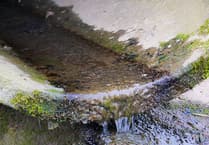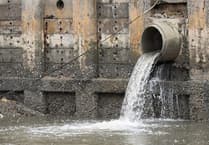The River Teifi that flows through Ceredigion saw the longest total duration of sewage discharges of any river in Wales last year – and among the most of any in the country.
Data from water provider Dŵr Cymru and environmental regulator Natural Resource Wales (NRW) shows there have been more than 4,000 storm overflows in the Ceredigion area in 2021.
This equates to 40,200 hours of effluent spewing into the region’s rivers, seas and waterways – equivalent to more than four-and-a-half years. This is the ninth highest rate in the country.
The river Teifi flows down from Llyn Teifi in the Cambrian Mountains to its estuary in Cardigan.
It is also one of the longest rivers in Wales, stretching 76 miles through the Ceredigion countryside, flowing past Tregaron and Lampeter.
The river saw nearly 19,500 hours of cumulative sewage overflows during 2021, including about 2,300 separate discharges.
This was just ahead of the Dee, Wye and Usk rivers.
Dŵr Cymru does not dispute the data but says it has not yet verified the analysis despite it being in the public domain for more than year.
The Teifi’s health has been on the radar of NRW for several years, with phosphate pollution a particular concern.
The state of the river has been so poor for so long that many nearby planning applications have been halted while it continues to be monitored.
This month we reported on the concerns of Talgarreg businessman Clinton Jones who sent us a video of water ‘running black with slurry’ in the Cletwr river – one of the main tributaries of the Teifi.
He described the state of the river as ‘heartbreaking’ and said his childhood was spent catching fish in the Cletwr.
Ceredigion MS Elin Jones told us: “It’s disappointing to see that there are still a large number of sewage dumps in Ceredigion, although it’s encouraging to see that the numbers are on a downward trend.
“We rely on our rivers for tourism as well as their natural functions as part of the wider ecosystem.
“We should be doing more to ensure that the quality of the water is as high as possible, and further investment is needed by Dŵr Cymru to strengthen their resources, improving the data they collect, and enhance our abilities to cut down on pollution activities.”
Ceredigion, which contains the famous sandy beaches of Cardigan Bay, includes more than 50 miles of coastline along with a spectacular mountainous hinterland.
The lifeblood of the area is its natural environment from which its agricultural economic base has always flourished.
Along with the Teifi and the Dyfi, the Ystwyth river which runs from the Cambrian Mountains on the border of neighbouring Powys, flows down and eventually adjoins with the Rheidol river and out to Aberystwyth.
Top of the Poops analysis suggests it has also seen 203 sewage dumps lasting a total of more than 2,000 hours.
More worrying still, Aberystwyth South Beach – a hugely popular bathing destination for locals and tourists – saw more than 200 storm overflows last year, lasting for more than 2,000 hours, according to data.
Chief executive officer of the West Wales River Trust, Harriet Alvis, said: “As a predominately rural area, agriculture has been found in research to be the main contributor to river pollution in many of our rivers in west Wales.
“However, west Wales has not received the level of investment in sewage infrastructure needed to match population growth, and as a result, CSOs and sewage treatment works are a significant part of the reason for water quality declines in some of our rivers.
“West Wales Rivers Trust also have concerns about the wider chemical products that are present in untreated sewage waste, such as prescription and non-prescription medication, and their impacts on wider ecology.
“We believe that all contributors to river pollution in our catchments need to receive greater regulation if we are to see a change in current water quality declines.”
She pointed to Welsh Water and NRW data showing there is approximately 45kg of phosphorous discharged on a daily basis in the Teifi, but sewage overflows only contribute to about three per cent of it. This is in line with data for water pollution contributions across Welsh waterways.
In response to Top of the Poops data, Welsh Water claims to have the lowest percentage of faulty or uninstalled monitoring devices of any water company in the UK, leading to it logging more discharges which inflates the figures.
Only 15 per cent of the firm’s monitors are listed as inactive or faulty compared to more than 45 per cent for some English firms, analysis by the Liberal Democrats suggests.
Welsh Water claims there are thousands of CSO drains in rivers and seas across the country but 99.5 per cent have got an active monitor.
But a spokesperson for Top of the Poops, however, confirmed to us the analysis shows the relative amount of sewage that is being dumped, not the absolute amount – so the figures won’t be inflated due to more effective monitoring.
They described the attempted rebuttal as a ‘classic diversionary tactics’ designed to deflect attention to other providers or other issues.
The NRW reports that about 40 per cent of Welsh rivers are rated as ‘Good’ or better status, which is far greater than only 15 per cent of English rivers and waterways.
But it also reported last year that over 60 per cent of Wales’ Special Areas of Conservation (SAC) rivers are failing against their phosphate target.
Ben Lake, MP for Ceredigion, told the Cambrian News: “It is always concerning to read of sewage discharges into our rivers, although I am pleased to see that the rates in Ceredigion have decreased in the past 12 months.
“I fully supported the Sewage (Inland Waters) Bill, which was backed by the Surfers Against Sewage campaign, but unfortunately it failed to complete its passage through Parliament. More recently, during the debate on the UK Environment Act, elements of which apply to Wales, I voted in favour of amendments that would have prevented water companies from continuing with the practice of discharging sewage into our waterways, and at the latest stage of proceedings I voted for the ‘Duke of Wellington’ amendment, which would have introduced a legal obligation to eliminate the practice completely.
“I am committed to bringing the natural environment of Wales to a better state, and in particular the restoration of habitats. I know that my colleagues in the Senedd in Cardiff are pressing the Welsh Government to improve the quality of our waterways and they have my full support.”
Further details on the Duke of Wellington amendment can be read here: Amendment 60 to Environment Act 2021 - Parliamentary Bills - UK Parliament.
Here’s what Welsh Water had to say...
“In the short time provided to respond to this article, it has not been possible to validate the spill numbers quoted by Top of the Poops. We submit our spill numbers annually to our regulator NRW and these are always available to view on our website by anyone at any time.
“It is important to be clear from the outset that the higher spills numbers from our Combined Storm Overflows (CSOs) does not mean that Welsh Water is a poor performer in this area and the numbers must be viewed in the context of two key facts.
“Firstly, Welsh Water is committed to protecting bathing and river water quality and has invested over £8 million on installing monitors on its CSOs to record spill numbers. The company now has monitors on 99.5 per cent of its CSOs which exceeds the coverage of other water companies. This means that Welsh Water has much more data to report on its CSOs to its regulators and so it’s unsurprising that it records larger numbers of spills than others.
“Secondly, due to its geographical location on the British Isles, Wales naturally receives more rainfall than other parts of the UK. As CSOs are designed to operate during heavy rainfall to help protect communities from flooding, our CSOs operate more frequently. Snowdonia National Park for example is amongst the wettest places in the UK and to bring this to life, in February 2020, Capel Curig saw 224mm of rain for the month compared to the UK average of just 97mm of rain. Currently the average spill number for Welsh CSOs is around 33 times per year. If we had the rainfall of Cambridge for instance, the average spill number would be 13 times per year. Their operation is a function of the rainfall we receive in Wales.
“We recognise however that with environmental legislation tightening and customer expectations changing, more needs to be done. Removing CSOs from our system is not an option but what is in our control is the ability to target investment to CSOs which have the biggest impact so that we can improve their performance. That is why we are investing £936 million to 2025 on further improvements to our network.
“Welsh Water has always taken its responsibility for operating CSOs responsibly and invested more than £1 billion as testament to this over the years. This has delivered real improvements and helped ensure that Wales has over a third of the UKs Blue Flag beaches while only having 15 per cent of the coastline.”
Have you found water in your area to be unexpectedly dirty? Send your videos and photos to [email protected]







Comments
This article has no comments yet. Be the first to leave a comment.